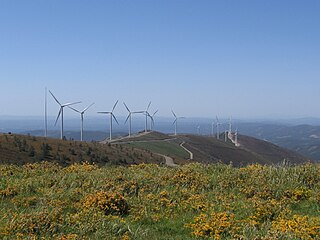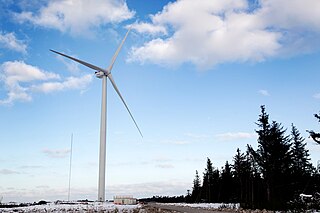
A wind farm or wind park, also called a wind power station or wind power plant, is a group of wind turbines in the same location used to produce electricity. Wind farms vary in size from a small number of turbines to several hundred wind turbines covering an extensive area. Wind farms can be either onshore or offshore.

Iberdrola is a Spanish multinational electric utility company based in Bilbao, Spain. Iberdrola has a workforce of around 40,000 employees serving around 30 million customers. Subsidiaries include Scottish Power and a significant part of Avangrid, amongst others. As of 2023, the largest shareholder of the company is the Qatar Investment Authority, with BlackRock and Norges Bank also holding significant interests.

The United Kingdom is the best location for wind power in Europe and one of the best in the world. The combination of long coastline, shallow water and strong winds make offshore wind unusually effective.

Wind power is the fastest-growing renewable energy technology in Scotland, with 11,482 megawatts (MW) of installed wind power capacity by Q1 2023. This included 9,316 MW from onshore wind in Scotland and 2,166 MW of offshore wind generators.

Wind power' is a major source of energy in Portugal. At the end of 2020, wind power capacity in Continental Portugal was 5,456 MW. In 2020, wind power represented 23.7% of total electricity generation.

China is the world leader in wind power generation, with the largest installed capacity of any nation and continued rapid growth in new wind facilities. With its large land mass and long coastline, China has exceptional wind power resources: Wind power remained China's third-largest source of electricity at the end of 2021, accounting for 7.5% of total power generation.

A floating wind turbine is an offshore wind turbine mounted on a floating structure that allows the turbine to generate electricity in water depths where fixed-foundation turbines are not feasible. Floating wind farms have the potential to significantly increase the sea area available for offshore wind farms, especially in countries with limited shallow waters, such as Spain, Portugal, Japan, France and the United States' West Coast. Locating wind farms further offshore can also reduce visual pollution, provide better accommodation for fishing and shipping lanes, and reach stronger and more consistent winds.
New York has 2,192 MW of installed wind power capacity as of 2022. Most of New York's wind power is located in upstate New York as onshore wind farms. New York has set a goal of developing 9,000 MW of offshore installed wind power capacity by 2035 that will power an estimated 6 million homes. As of October 2022, New York has five offshore wind farms in development with approximately 4,300 MW installed capacity.
Neart Na Gaoithe is an offshore wind farm under construction in the outer Firth of Forth, 30 kilometres (19 mi) north of Torness. It has a potential capacity of 450 MW. It is being developed by EDF Renewables and ESB. Offshore work began in 2020, with completion originally planned for 2023 but delayed due to supply chain challenges until 2024.

Offshore wind power or offshore wind energy is the generation of electricity through wind farms in bodies of water, usually at sea. There are higher wind speeds offshore than on land, so offshore farms generate more electricity per amount of capacity installed. Offshore wind farms are also less controversial than those on land, as they have less impact on people and the landscape.

Wind power in Belgium has seen significant advancements, starting with the generation of electricity from offshore wind farms in 2009. By 2020, the capacity of these offshore farms reached 2,262 megawatts (MW), matching the combined output of Belgium's largest nuclear reactors, Doel 4 and Tihange 3. Concurrently, the development of on-shore wind energy, which remained minimal until 2004, experienced significant growth, with installed capacity and production doubling annually from 96 MW in 2004 to 2,476.1 MW by 2021. The percentage of electricity demand met by wind grew to about 14.4% by 2020.

As of November 2023, wind power in the Netherlands has an installed capacity of 11,602 MW, 40.9% of which is based offshore. In 2022, the wind turbines provided the country with 18.37% of its electricity demand during the year. Windmills have historically played a major part in the Netherlands by providing an alternative to water driven mills.

The Vestas V164 is a three-bladed offshore wind turbine, produced by Vestas, with a nameplate capacity of up to 10 megawatts, a world record. Vestas revealed the V164's design in 2011 with the first prototype unit operated at Østerild in northern Denmark in January 2014. The first industrial units were installed in 2016 at Burbo Bank, off the west coast of the United Kingdom. By 2021, Vestas had produced 500 of the series.
Hornsea Wind Farm is a Round 3 wind farm which began construction in 2018. Sited in the North Sea 120 km (75 mi) off the east coast of England, the eventual wind farm group is planned to have a total capacity of up to 6 gigawatt (GW).

Hywind Scotland is the world's first commercial wind farm using floating wind turbines, situated 29 kilometres (18 mi) off Peterhead, Scotland. The farm has five 6 MW Siemens direct-drive turbines on Hywind floating monopiles, with a total capacity of 30 MW. It is operated by Hywind (Scotland) Limited, a joint venture of Equinor (75%) and Masdar (25%).
The United Kingdom became the world leader of offshore wind power generation in October 2008 when it overtook Denmark.














